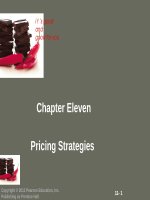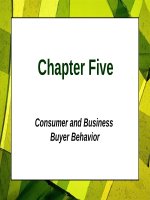Lecture Principles of Marketing - Chapter 7: Product, services, and branding strategy
Bạn đang xem bản rút gọn của tài liệu. Xem và tải ngay bản đầy đủ của tài liệu tại đây (245.13 KB, 37 trang )
Chapter Seven
Product, Services, and Branding
Strategy
Roadmap: Previewing the Concepts
1.
2.
3.
4.
5.
Define product and the major classifications of
products and services.
Describe the decisions companies make
regarding their individual products and
services, product lines, and product mixes.
Discuss branding strategy – the decisions firms
make in building and managing their brands.
Identify the four characteristics that affect the
marketing of a service and the additional
marketing considerations that services require.
Discuss two additional product issues: socially
responsible product decisions and international
product and services marketing.
Copyright 2007, Prentice Hall, Inc.
7-2
Case Study
FIJI Water – “The Taste of Paradise”
Product
Promotion
Brand name: FIJI Natural
Artesian Water.
Product source: comes
from an underground
location in Fiji islands.
Key benefits: ultra-clean
taste, no impurities or
pollutants.
Brand image: “The Taste
of Paradise”
It’s a brand experience!
Name, packaging, label,
celebrity endorsers and
places through which it is
sold contributes to “Taste
of Paradise” imagery.
Ads evoke exotic origins:
tropical forest, volcanoes.
High price charged
supports premium appeal.
What Is a Product?
Anything that can be offered to a
market for attention, acquisition, use,
or consumption and that might satisfy
a want or need.
– Includes: physical objects, services,
events, persons, places, organizations,
ideas, or some combination thereof.
What Is a Service?
A form of product that consists of
activities, benefits, or satisfactions
offered for sale that are essentially
intangible and do not result in the
ownership of anything.
– Examples: banking, hotel, airline, retail, tax
preparation, home repairs.
Market Offerings
Continuum ranges from pure tangible
goods (with no services) to pure
services (with no good component)
with many combinations in between.
– Pure good: Camay soap.
– Pure service: Legal representation.
– Combination: Restaurant meal.
Creating and managing customer
experiences differentiates offers.
Levels of a Product
Core benefit
– What the consumer is really buying.
Actual product
– Includes the brand name, features, design,
packaging, quality level.
Augmented product
– Additional services and benefits such as
delivery and credit, instructions,
installation, warranty, service.
Consumer Products
Products and services bought by final
consumers for personal consumption.
– Also includes other marketable entities.
Classified by how consumers buy them.
Convenience Products
Purchased frequently and immediately
Low priced
Mass advertising
Many purchase locations
– Examples: candy, soda, newspapers
Shopping Products
Bought less frequently
Higher price
Fewer purchase locations
Comparison shop
– Examples: furniture, clothing, cars,
appliances
Specialty Products
Special purchase efforts
High price
Unique characteristics
Brand identification
Few purchase locations
– Example: Lamborghini, Rolex Watch
Unsought Products
New innovations
Products consumers do not want to
think about
Require much advertising and personal
selling
– Examples: life insurance, cemetery plots,
blood donation
Industrial Products
Those purchased for further
processing or for use in conducting
business.
– Distinction between consumer and
industrial products is based on the
purpose for which an item is bought.
Industrial Products
Materials and parts:
– Raw materials, manufactured materials,
and parts
Capital items:
– Products that aid in buyer’s production or
operations
Supplies and services:
– Operating supplies, repair, and
maintenance items
Other Market Offerings
Organizations: Profit (businesses) and
nonprofit (schools and churches).
– Includes corporate image advertising.
Persons: Politicians, entertainers, sports
figures, doctors, and lawyers.
Places: Create, maintain, or change attitudes
or behavior toward particular places (e.g.,
tourism).
Ideas (social marketing): Public health
campaigns, environmental campaigns, family
planning, or human rights.
Individual Product Decisions
Product attributes
Branding
Packaging
Labeling
Product support services
Product & Service Attributes
Product quality
– Performance quality
– Conformance quality
Features
– Value to consumer
– Cost to company
Style and design
– Influences experience
Branding
Creating, maintaining, protecting, and
enhancing products and services.
A brand is a name, term, sign, symbol,
or design, or a combination of these,
that identifies the maker or seller of a
product or service.
Branding
Advantages to buyers:
– Product identification
– Product quality
Advantages to sellers:
– Basis for product’s quality story
– Provides legal protection
– Helps to segment markets
Packaging
Designing and producing the container
or wrapper for a product.
Developing a good package:
– Market the brand
– Protect the elements
– Ensure product safety
– Address environmental concerns
Labeling
Printed information appearing on or
with the package.
Performs several functions:
– Identifies product or brand
– Describes several things about the
product
– Promotes the product through attractive
graphics
Product Support Services
Assess the value of current services
and obtain ideas for new services.
Assess the cost of providing the
services.
Put together a package of services that
delights the customers and yields
profits for the company.
Product Line Decisions
Product line length:
– The number of items in a product line.
Adjust line length by:
– Stretching
• Downward
• Upward
• Both directions
– Filling
Product Mix Decisions
Product mix:
– all of the product lines and items that a particular
seller offers for sale.
Product mix dimensions include:
– Length: the number of items in a line.
– Width: the number of different product lines the
company carries.
– Depth: the number of versions offered of each
product in the line.
– Consistency: how closely related various lines are.
Brand Equity
The positive differential effect that
knowing the brand name has on
customer response to the product or
service.
Provides:
– More brand awareness and loyalty
– Basis for strong, profitable customer
relationships









